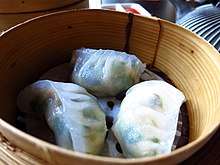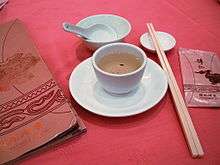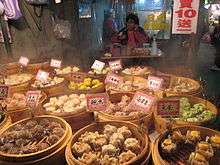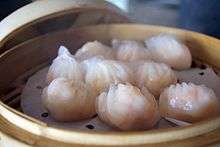Dim sum
Dim sum (simplified Chinese: 点心; traditional Chinese: 點心; pinyin: diǎnxīn; Cantonese Yale: dímsām) is a style of Chinese cuisine. It is prepared as small bite-sized portions of food served in small steamer baskets or on a small plate. Dim sum is generally considered Cantonese, although other varieties exist. Dim sum dishes are usually served with tea and together form a full tea brunch. Due to the Cantonese tradition of enjoying tea with this cuisine, yum cha (simplified Chinese: 饮茶; traditional Chinese: 飲茶; pinyin: yǐn chá), which means "drink tea" in Cantonese, is also synonymous with dim sum.[1] Dim sum traditionally are served as fully cooked, ready-to-serve dishes. In some Cantonese teahouses, carts with dim sum are served around the restaurant.

| Dim sum | |||||||||||||||||||||
|---|---|---|---|---|---|---|---|---|---|---|---|---|---|---|---|---|---|---|---|---|---|
.svg.png) "Dim sum" in Traditional (top) and Simplified (bottom) Chinese characters | |||||||||||||||||||||
| Traditional Chinese | 點心 | ||||||||||||||||||||
| Simplified Chinese | 点心 | ||||||||||||||||||||
| Cantonese Yale | dímsām | ||||||||||||||||||||
| |||||||||||||||||||||
Etymology
The original meaning of the term dim sum is unclear and debated.[2]
Some believe that the term originated in the Eastern Jin dynasty (317–420).[3][4] According to legends, an unnamed general ordered civilians to make buns and cakes and send them to the front line, in order to express his gratitude towards his soldiers after battles. Gratitude in Chinese is 點點心意; diǎn diǎn xīnyì, which was later shortened to 點心 (dim sum), while the term represents dishes which are made in a similar fashion.
However, the accuracy of the above account is not supported by any historical text. Some also believe this event happened in the Southern Song dynasty,[5][6] (960–1279) which existed after the earliest historical record of the term was written (see below), thus contradicts the notion that this event is its origin.
The earliest definite record of the term is the Book of Tang (唐書; Táng shū, written in the Five Dynasties and Ten Kingdoms period, 907–979),[4] in which dim sum was used as a verb instead of a noun. The exact quote is 「治妝未畢, 我未及餐, 爾且可點心」; "Zhì zhuāng wèi bì, wǒ wèi jí cān, ěr qiě kě diǎnxīn", which means "I have not finished preparing myself and been ready for a proper meal, therefore you can treat yourself with some small snacks". In this particular context, although 點心 (dim sum) literally means "to lightly touch (your) heart", a more accurate translation is "to barely fill (your) stomach".
Later texts used the term as a noun. For instance, the Record of the Northern Journey (北轅錄; Běi yuán lù, written in the Song dynasty) mentions 「洗漱冠飾畢, 點心已至」; "Xǐshù guān shì bì, diǎnxīn yǐ zhì", which means "dim sum has already arrived when the grooming is done". Dim sum can be understood as "snacks" in this quote.
In short, although its original meaning is unclear, the term has been commonly used to describe small dishes since no later than the Song dynasty.
History
As stated in the etymology section, the term "dim sum" can be historically traced back to the Tang and Song dynasties, or even the Eastern Jin dynasty if legends were to be believed.
However, the history of dim sum dishes themselves is another matter.
Dim sum is usually linked with the practice of yum cha (Chinese: 飲茶; Cantonese Yale: yám chàh; pinyin: yǐnchá; literally: 'drink tea'), which is a much older tradition and can be conceptualised as a Cantonese tradition of brunch. It is believed that yum cha was associated with teahouses established along the ancient Silk Road which served as places for travelers to rest. People later discovered that tea can aid in digestion, so teahouse owners began adding various snacks and this eventually evolved into the modern yum cha practice.[7] The modern form of dim sum is believed to originate in Guangzhou (or Canton) and later transmit southward to Hong Kong,[8] whose people over the centuries transformed yum cha from a relaxing respite to a formal dining experience.
Thus, the various dishes of dim sum can possibly have a longer history than the term itself.
Cuisine
In Cantonese-speaking regions (such as Hong Kong and Guangdong), yum cha is sometimes described as 一盅兩件 (literally "one cup accompanied by two pieces"), in which "cup" refers to tea, while "two pieces" refers to two pieces of dim sum which were historically bigger in size and could fill up one's stomach. Nowadays, however, it is common that people would order much more than two dishes during yum cha.
Many Cantonese restaurants start serving dim sum as early as five in the morning, and each restaurant will have its own signature dim sum dish.[9] It is a tradition for the elderly to gather to eat dim sum after morning exercises. For many in southern China, yum cha is treated as a weekend family day. More traditional dim sum restaurants typically serve dim sum until mid-afternoon. However, in modern society, it has become commonplace for restaurants to serve dim sum at dinner time; various dim sum items are even sold as take-out for students and office workers on the go.
A traditional dim sum brunch includes various types of steamed buns such as cha siu bao (a steamed bun filled with barbecue pork), rice or wheat dumplings and rice noodle rolls, which contain a range of ingredients, including beef, chicken, pork, prawns, and vegetarian options. Many dim sum restaurants also offer plates of steamed green vegetables, roasted meats, congee and other soups. Dessert dim sum is also available and many places offer the customary egg tart. Dim sum is usually eaten as breakfast or brunch.
Dim sum can be cooked by steaming and frying, among other methods. The serving sizes are usually small and normally served as three or four pieces in one dish. It is customary to order family style, sharing dishes among all members of the dining party. Because of the small portions, people can try a wide variety of food.
Dishes
Dim sum brunch restaurants have a wide variety of dishes, usually several dozen. Among the standard fare of dim sum are the following:
Dumpling

- Shrimp dumpling (蝦餃; xiā jiǎo; hā gáau): Steamed dumpling with shrimp filling.[10]
- Teochew dumpling (潮州粉粿; cháozhōu fěnguǒ; Chìu jāu fán gwó): Steamed dumpling with peanuts, garlic, Chinese chives, pork, dried shrimp, and Chinese mushrooms.
- Chive dumpling (韭菜餃): Steamed dumpling with Chinese chives.
- Xiao long bao (小笼包; 小籠包; xiǎolóngbāo; síu lùhng bāau): Dumplings are filled with meat or seafood with a rich broth inside.
- Guotie (鍋貼; guōtiē; wōtip): Pan-fried dumpling, usually with meat and cabbage filling.
- Shaomai (烧卖; 燒賣; shāomài; sīu máai): Steamed dumplings with pork and prawns. Usually topped off with crab roe and mushroom.
- Taro dumpling (芋角; yù jiǎo; wuh gok): Deep fried dumpling made with mashed taro, stuffed with diced mushrooms, shrimp and pork.
- Haam Seui Gok (鹹水角; xiánshuǐ jiǎo; hàahm séui gok): Deep fried dumpling with pork and chopped vegetables. The wrapping is sweet and sticky, while the filling is slightly salty and savoury.
- Dumpling soup (灌湯餃; guàntāng jiǎo; guntōng gáau): Soup with one or two big dumplings.
Roll
- Spring roll (春卷; 春捲; chūnjuǎn; chēun gyún): A deep fried roll consisting of various sliced vegetables (such as carrot, cabbage, mushroom and wood ear fungus) and sometimes meat.
- Tofu skin roll (腐皮捲; fǔpíjuǎn; fuh pèih gyún): A roll made of tofu skin filled with various meat and sliced vegetables.
- Fresh bamboo roll (鮮竹卷): A roll made of tofu skin filled with minced pork and bamboo shoot. Typically served in an oyster sauce broth.
- Four-treasure chicken roll (四寶雞扎): A roll made of tofu skin filled with chicken, Jinhua ham, fish maw (花膠) and Chinese mushroom.
- Rice noodle roll (腸粉; chángfěn; chéungfán): Steamed rice noodles, rolled and filled with meats or vegetables inside but can be served plain. Popular fillings include beef, dough fritter, shrimp, and barbecued pork. Often served with a sweetened soy sauce.
- Zhaliang (炸兩; jaléung): Steamed rice noodles, rolled around youjagwai (油炸鬼). Typically doused in soy sauce, hoisin sauce or sesame paste and sprinkled with sesame seeds.
Bun
- Barbecued pork bun (叉燒包; chāshāo bāo; chāsīu bāau): Buns with barbecued pork filling. They can either be steamed to be white and fluffy or glazed and baked to golden. The baked variant are called (叉燒餐包; chāshāo cān bāo; chāsīu chāan bāau).
- Sweet cream bun (奶黃包; nǎihuáng bāo; náaih wòhng bāau): Steamed buns with milk custard filling.
- Lotus paste bun (蓮蓉包): Steamed buns with lotus seed paste filling.
- Pineapple bun (菠蘿包; bōluó bāo; bōlòh bāau): a bread roll with a topping textured like pineapple skin, usually sweet. Does not contain pineapple.
Cake
- Turnip cake (蘿蔔糕; luóbo gāo; lòh baahk gōu): puddings made from shredded white radish, mixed with bits of dried shrimp, Chinese sausage and mushroom. They are steamed, then cut into slices and pan-fried.
- Taro cake (芋頭糕; yùtou gāo; wuh táu gōu): puddings made of taro.
- Water chestnut cake (馬蹄糕; mǎtí gāo; máh tàih gōu): puddings made of crispy water chestnut. Some restaurants also serve a variation made with bamboo juice.
Meat
- Steamed meatball (山竹牛肉丸; niúròu wán; ngàuh yuhk yún): Steamed meatballs served on top of a thin tofu skin.
- Phoenix claws (鳳爪; fèngzhuǎ; fuhng jáau): Deep fried, boiled and then steamed chicken feet with douchi. A plain steamed version is known as "White Cloud Phoenix Claws" (白雲鳳爪; báiyún fèngzhuǎ; baahk wàhn fuhng jáau).
- Spare ribs (排骨; páigǔ; pàaih gwāt): Steamed pork spare ribs with douchi and sometimes garlic and chili.
- Pork rinds and radish (豬皮蘿蔔): Boiled and steamed pork rind and radish
- Pork blood (豬紅): Stir-fried pork blood with douchi and scallion
- Beef tendon (牛筋)
- Reticulum beef tripe (金錢肚)
- Omasum beef tripe (牛百頁; 牛柏葉)
- Beef entrails (牛什; 牛雜): Pieces of beef entrails such as tripe, pancreas, intestine, spleen, and lung; served in a bowl of master stock
- Siu mei (烧味; 燒味; shāowèi; sīuméi): Hong Kong-style barbecue meat roasted in an oven. Popular varieties include char siu (Chinese: 叉燒), siu ngo (Chinese: 燒鵝), siu aap (Chinese: 燒鴨), white cut chicken (Chinese: 白切雞), soy sauce chicken (Chinese: 豉油雞), and siu yuk (Chinese: 燒肉).
- Chicken wing (Chinese: 雞翼): Served in two varieties: deep fried (Chinese: 炸雞翼) or marinated in soy sauce and spices (Chinese: 瑞士雞翼)
Seafood
- Deep fried squid (炸鱿鱼须; 炸魷魚鬚; zhàyóuyúxū; ja yàuh yùh sōu): Similar to fried calamari, the battered squid is deep-fried.
- Curry squid (咖哩鱿鱼; 咖哩魷魚): Squid served in a curry broth.
Vegetable
Rice
- Lotus leaf rice (糯米雞; nuòmǐ jī; noh máih gāi): Glutinous rice wrapped in a lotus leaf. Typically contains egg yolk, dried scallop, mushroom, and meat (usually pork and chicken). A lighter variant is known as "pearl chicken" (珍珠雞; zhēnzhū jī; jānjyū gāi).
- Chinese sticky rice (糯米飯; nuòmǐ fàn; noh máih faahn): Stir fried (or steamed) glutinous rice with savoury Chinese sausage, soy sauce steeped mushrooms, sweet spring onions, and sometimes chicken marinated with a mixture of spices including five-spice powder.
- Congee (粥; zhōu; jūk): Rice porridge such as the "Preserved Egg and Pork Porridge" (皮蛋瘦肉粥; pídàn shòuròu zhōu; pèihdáan sauyuhk jūk)
Dessert
- Egg tart (Chinese: 蛋撻; pinyin: dàntǎ; Cantonese Yale: daahn tāat): Baked tart with egg custard filling.
- Tofu pudding (豆腐花; dòufuhuā; dauh fuh fā): Soft tofu served with a sweet ginger or jasmine flavored syrup.
- Sesame ball (煎堆; jiānduī; jīn dēui): Deep fried chewy dough with red bean paste filling, coated in sesame seeds.
- Thousand-layer cake (千層糕; qiāncéng gāo; chīnchàhng gōu): A dessert made up of many layers of sweet egg dough.
- Malay sponge cake (馬拉糕; mǎlā gāo; máhlāai gōu): Steamed sponge cake flavoured with molasses.
- White sugar sponge cake:(白糖糕; báitáng gāo; baahk tòng gōu): Steamed sponge cake made with white sugar.
- Coconut pudding (椰汁糕; yēzhī gāo; yèh jāp gōu): Light and spongy but creamy puddings made with coconut milk, with a thin clear jelly layer made with coconut water on top.
- Mango pudding (芒果布甸; mángguǒ bùdiàn; mōnggwó boudīn): A sweet, rich mango-flavoured pudding usually with large chunks of fresh mango; often served with a topping of evaporated milk.
- Ox-tongue pastry (牛脷酥): A fried dough that is elliptical in shape and resembles an ox tongue. Similar to youjagwai, but sugar is added to the flour.
- Tong sui (糖水): Popular varieties include black sesame soup (芝麻糊), red bean soup (红豆汤; 紅豆沙), mung bean soup (绿豆汤; 綠豆沙), sai mai lo (西米露), guilinggao (龟苓膏; 龜苓膏), peanut paste soup (花生糊), and walnut soup (核桃糊).
Tea service

The drinking of tea is as important to dim sum as the food. The type of tea to serve on the table is typically one of the first things the server asks dining customers. Several types of tea are served during dim sum :
Chrysanthemum tea – Chrysanthemum tea does not actually contain any tea leaves. Instead it is a flower-based tisane made from chrysanthemum flowers of the species Chrysanthemum morifolium or Chrysanthemum indicum, which are most popular in East Asia. To prepare the tea, chrysanthemum flowers (usually dried) are steeped in hot water (usually 90 to 95 °C (194 to 203 °F) after cooling from a boil) in either a teapot, cup, or glass. However, Chrysanthemum flowers are often paired with Pu-erh tea, and this is often referred to as guk pou (Chinese: 菊普; pinyin: jú pǔ; Cantonese Yale: gūk póu).
Green tea – Freshly picked leaves only go through heating and drying processes, but do not undergo oxidation. This enables the leaves to keep their original green color and retain most natural substances like polyphenols and chlorophyll contained within the leaves. This kind of tea is produced all over China and is the most popular category of tea. Representative varieties include Dragon Well (Chinese: 龍井; pinyin: lóngjǐng; Cantonese Yale: lùhngjéng) and Biluochun from Zhejiang and Jiangsu Provinces respectively.
Oolong tea – The tea leaves are partially oxidized, imparting to them the characteristics of both green and black teas. Its taste is more similar to green tea than black tea, but has a less "grassy" flavor than green tea. The three major oolong-tea producing areas are on the southeast coast of China e.g. Fujian, Guangdong and Taiwan. Tieguanyin (Chinese: 鐵觀音; pinyin: tiěguānyīn; Cantonese Yale: titgūnyām), is one of the most popular choice of tea. It is originally cultivated in Fujian province and is a premium variety of Oolong tea with delightful fragrance.
Pounei tea (Cantonese) or Pu-erh tea (Mandarin) – The tea has undergone years of fermentation, giving them a unique earthy flavor. This variety of tea is usually compressed into different shapes like bricks, discs and bowls.
Scented teas – There can be various mixtures of flowers with green tea, black tea or oolong tea. Flowers used include jasmine, gardenia, magnolia, grapefruit flower, sweet-scented osmanthus and rose. There are strict rules about the proportion of flowers to tea. Jasmine tea is the most popular type of scented tea, and is often the most popular type of tea served at yum cha establishments.
Restaurants and pricing

One aspect unique to dim sum is its method of serving in specialized dim sum brunch restaurants or teahouses.[11] Here, dishes are pushed around the restaurant in steam-heated carts, with servers offering the dishes to customers.[11][12] Pricing of dishes at these types of restaurants may vary, but traditionally the dishes are classified as "small", "medium", "large", "extra-large", or "special". For example, a basket of dumplings may be considered a small dish, while a bowl of congee or plate of lo mai gai may be considered a large dish. Dishes are then priced accordingly by size, with orders typically recorded with a rubber stamp onto a bill card that remains on the table. Servers in some restaurants use distinctive stamps, so that sales statistics for each server can be recorded. Menu items not typically considered dim sum fare, such as a plate of chow mein, are often available; they are typically branded as "kitchen" dishes on menus and are individually priced. When done eating, the customers simply call the waiters over and the bill is calculated based on the number of stamps in each priced section.
Another way of pricing the food consumed is to use the number and color of the dishes left on the patron's table as a guide, similar to the method used in some Japanese conveyor belt sushi restaurants. Some newer restaurants offer a "conveyor belt dim sum" format, similar to the conveyor belt sushi eating places.
Other Chinese restaurants may not offer dim sum on moving platforms, and instead take orders, generally on a pre-printed sheet of paper, and serve à la carte, in a manner similar to a Spanish tapas restaurant. Prices of each dim sum dish may then vary depending on the actual dish ordered. This procedure may be used at less busier times in specialized restaurants, as it saves time and resources by chefs not having to anticipate which dishes would be ordered and prepare them in advance; though for the customer, it may take longer for the dishes to be delivered after ordering.
Fast food
Instant dim sum as a fast food has come onto the market in Hong Kong,[13] Mainland China,[14] Taiwan, Vietnam, the Philippines, Indonesia, Singapore, Thailand, and Malaysia. People can enjoy snacks after a three-minute defrosting or reheating of the instant dim sum in a microwave oven.[13]
In many cities, "street dim sum" is sold from mobile carts and usually consists of dumplings or meatballs steamed in a large container and served on a bamboo skewer. The customer can dip the whole skewer into a sauce bowl and then eat while standing or walking.
Dim sum can be purchased from major grocery stores in most countries with a Chinese population. These dim sum can be easily cooked by steaming or microwaving. Major grocery stores in Hong Kong, Vietnam, the Philippines, Singapore, Taiwan, Mainland China, Indonesia, Malaysia, Brunei, Thailand, Australia, United States, and Canada have a variety of frozen or fresh dim sum stocked at the shelves. These include dumplings, shaomai, baozi, rice noodle roll, turnip cake and steamed spare ribs.
In Singapore, as well as other countries, dim sum can be purchased from convenience stores, coffee shops and other eateries. There is halal certified dim sum available (with chicken taking the place of pork) which is very popular in Malaysia, Indonesia and Brunei.
Gallery
 Shaomai (燒賣)
Shaomai (燒賣) Barbecued pork rice roll (叉燒腸)
Barbecued pork rice roll (叉燒腸) Shrimp dumpling (蝦餃)
Shrimp dumpling (蝦餃) Taro dumpling (芋角)
Taro dumpling (芋角) Egg custard tarts (蛋撻)
Egg custard tarts (蛋撻)
See also
- Cantonese cuisine
- Chinese cuisine
- Dim sim, Australian dumpling inspired by dim sum, with origins in local Cantonese restaurants.
- Hong Kong cuisine
- List of brunch foods
- List of dumplings
References
- Wong, Adele (1 November 2016). Hong Kong Food & Culture: From Dim Sum to Dried Abalone. Man Mo Media. ISBN 9887756008.
- "點心點解叫「點心」?". Bastille Post. 2016.
- 施, 莉雅 (2013). 精選美食王. 萬里.
- 蘇, 建新 (2011). 人人都要學的三分鐘國文課5: 常用詞語篇. 如果出版社.
- 劉, 利生 (2015). 影響世界的中國元素 - 中華美食. 元華文創.
- "吃「點心」與「閉門羹」的典故". 每日頭條. 2018.
- Parkinson, Rhonda. "Delicious Dim Sum – Chinese Brunch". About.com-Chinese Food. About.com. Retrieved 21 March 2013.
- Tam, S. (1997). Eating Metropolitaneity: Hong Kong Identity in yumcha. Australian Journal of Anthropology, 8(1), 291-306
- 梁廣福. (2015). 再會茶樓歲月 (初版. ed.). 香港: 中華書局(香港)有限公司
- Albala, Ken (2011). Food Cultures of the World Encyclopedia. 3. ABC-CLIO. p. 89. ISBN 978-0-313-37626-9 – via Google Books.
- Phillips, C. (2016). The Dim Sum Field Guide: A Taxonomy of Dumplings, Buns, Meats, Sweets, and Other Specialties of the Chinese Teahouse. Ten Speed Press. pp. 5–6. ISBN 978-1-60774-956-1. Retrieved 5 November 2016.
- Guides, R. (2010). The Rough Guide to Southeast Asia On A Budget. Rough Guides. p. 145. ISBN 978-1-4053-8686-9. Retrieved 5 November 2016.
- Wu, D.Y.H.; Tan, C.B. (2001). Changing Chinese Foodways in Asia. Academic monograph on Chinese food culture. Chinese University Press. p. 56. ISBN 978-962-201-914-0. Retrieved 5 November 2016.
- Ball, S.; Horner, S.; Nield, K. (2009). Contemporary Hospitality and Tourism Management Issues in China and India. Taylor & Francis. p. 91. ISBN 978-1-136-41459-6. Retrieved 5 November 2016.
